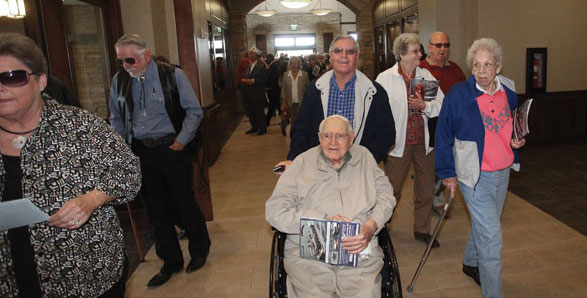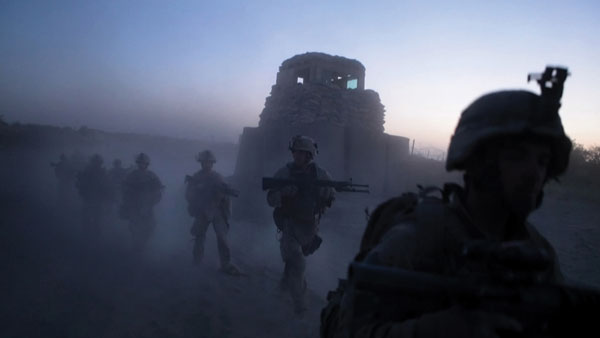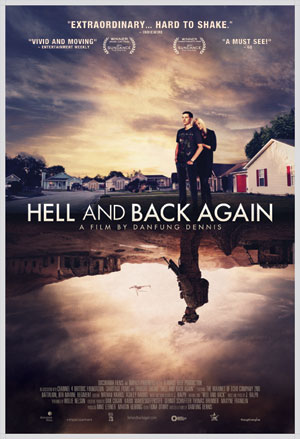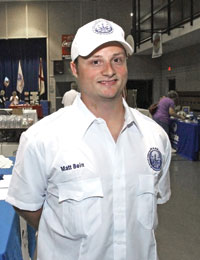New veterans home goes above and beyond expectations

Story by Carol Pappas
Photos by Jerry Martin
It may be an overused cliché when a sight is so mesmerizing, so impressive that it takes your breath away. But just inside the grand entrance to the Col. Robert L. Howard Veterans Home is a sight that … well … takes your breath away.
There is no institutional setting here — no hospital-like rooms lining the hallways, no dark corridors where the only light comes from an occasional window or door.
Step inside, and you think you are in a mall or strolling along a quaint downtown street. Vintage signs hang from the tops of a series of storefronts enclosed mainly in glass, not walls. Barber shop, pharmacy, beauty shop, library, chapel, Stars and Stripes Café. They line the stone-tiled corridor, beckoning one and all to come inside and have a look.
Once within, the light streaming through windowed walls overlooking an expanse of lush, green courtyards and meandering paths lets you know immediately this is indeed a special place.
“If you ask veterans where they would rather be, their answer would be, ‘I’d rather be at home.’ ” said Rear Adm. Clyde Marsh, commissioner of the Alabama Veterans Administration. “We tried to create a home they would like to go to and enjoy. We think the veterans will be happy here.”
Filling all of its 27 acres just north of Interstate 20 in Pell City, this sprawling town, as it could be known, has a main street, a town center, neighborhoods and homes all under roof.
Outside are courtyard gardens, and homes have classic back porches complete with rocking chairs.
The neighborhoods come together in what is called Town Center, a huge room with a towering stone fireplace heading upward to a skylight and pine cathedral ceilings. It has the look and feel of a Colorado ski lodge with fireplaces opening on two sides and cabinetry and large-screen televisions on the other two.
Floor-to-ceiling windows bathe the room in a warm glow — the kind of place where people will naturally gather. It can be used to hold events for the veterans as well, said Manda Mountain, who is the Alabama Department of Veteran’s Affairs director for the Col. Robert L. Howard Veterans Home.
From the town center are three neighborhoods with names like Victory Way, Liberty Lane and Patriot Place with three homes in each, enough room to accommodate 126 veterans.
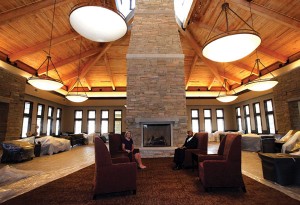 Architects get marching orders
Architects get marching orders
“Putting it in perspective, it’s a new design concept for state nursing homes for veterans,” Marsh said. Williams Blackstock Architects of Birmingham designed it “from the ground up.” There was no blueprint or model, just an admiral’s order to create a home worthy of veterans’ service and sacrifice, not an institution.
“We wanted it built with dignity, the comforts of home, serenity — all that in mind,” Marsh said. “We wanted a warm environment so people could enjoy it.”
That was no easy feat for 240,000 square feet on one level alone, said architect Joel Blackstock, principal-in-charge on the project. “Admiral Marsh really pushed us to make it state-of-the-art, not like any other.”
The concept was “ to provide a sense of community throughout for the residents because it really is like a small town or village,” he said. Lead architect Sean Whitt worked full-time on the site to oversee the construction process.
Existing facilities of this type are typically institutional in character, with nurses’ stations and rooms. Not here. It is divided into neighborhoods with three homes — each housing 14 veterans in their own private rooms. Once inside the home, instead of narrow hallways with rooms on each side, the centers are wide open and contain a full kitchen, a dining room and living room, with bedrooms on both sides — just like a home.
Meals are prepared in the main kitchen, but prepped in each home’s own spacious kitchen with all the amenities, so veterans can actually see and smell what is cooking before it is served in an adjoining dining room — all right there in their own home.
Each house has a living room, dining room and kitchen shared by a small group of residents. Three houses form a neighborhood with its own lobby, and there are private “family rooms” for out-of-the-way visits and overflow visitors. “The neighborhoods surround a town center, complete with a main street, similar to the small towns many of us grew up in,” Blackstock said.
Williams Blackstock interior designer Jennifer Tillman’s attention to detail is apparent — from the blend of aesthetic and patriotic paintings to a mix of leather and cloth sofas and chairs. They are the perfect complement to their homey surroundings. Private rooms feature tall wooden shelves with room for a large-screen television — all residents will have one — books, framed photos and other personal items. A stylish armoire holds a wardrobe.
While beds are equipped to move up and down like the hospital variety, headboards and footboards are made of wood, not metal, giving it more of a home-like look and feel.
Bathrooms are spacious — built for easy access — and huge walk-in showers are examples of the latest trends in home design. Every room has its own window with an exterior view.
A stroll down main street
Acting as tour guide on a walk down the building’s ‘main street,’ Marsh talks of how the Veterans Home got its name. Col. Robert L. Howard was an Alabama Army veteran, Medal of Honor winner and the most decorated soldier in history.
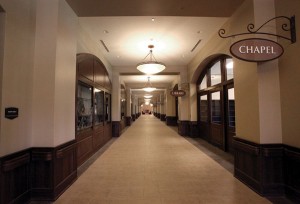 A glass display case built into the wall is dedicated to Howard’s life as a soldier. Five more cases line both sides of the main tiled avenue leading to the town center. They represent each branch of the service — Army, Navy, Air Force, Marines and Coast Guard, and all the cases will have memorabilia commemorating their service to country.
A glass display case built into the wall is dedicated to Howard’s life as a soldier. Five more cases line both sides of the main tiled avenue leading to the town center. They represent each branch of the service — Army, Navy, Air Force, Marines and Coast Guard, and all the cases will have memorabilia commemorating their service to country.
Kim Justice, executive director of state Veterans Homes, points out features along the way. And there are plenty of them.
The first feature that dominates a stop inside any of the ‘shops’ is oversized windows that frame a courtyard scene. “Each courtyard is unique with a wandering path that gives it a different look and feel,” she said.
Just down the way a bit is the Stars and Stripes Café, a sports bar where veterans can gather for pool, cards, checkers and other games. They can watch events on a big-screen TV and be served their favorite soft drink or “mocktail,” Justice said. “It’s a place to gather and enjoy each other.”
Just across the way is Eagle’s Landing, the main dining room. Both the café and the dining room open out into the town center, the focal point of the complex with walls of stone custom cut onsite to fit.
From the wood-beam ceilings to skylights to an imposing stacked-stone fireplace, the concept is “a resort town center. We were trying to capture it all,” Marsh said. It was a challenge to have a building this big meet the needs but still achieve the atmosphere it obviously conveys. “We are one of the first in the nation to have a home of this size, style and of this concept.”
From the town center, you can head in any of three directions to the neighborhoods. Along the way are multi-purpose rooms, conference rooms and whirlpool bathing suites.
On both sides of a grand lobby in the entrance to the building are a two-story domiciliary wing for more independent living in small apartments called Freedom Court and an Alzheimer’s/Dementia unit called American Harbor. This independent living area is the only one of its kind in Alabama veterans homes.
It is a veterans home of comprehensive care, the first of its kind in the state and a sharp departure from traditional veterans homes across the nation.
Partnerships fuel progress
The $50 million project’s location in Pell City did not happen by accident. Some pretty enticing variables came together at just the right time that made the decision an easier one for Alabama’s fourth veterans home.
St. Vincent’s St. Clair, the county’s new hospital, located just across the street. Jefferson State Community College, known for its nursing program, is just down the block on the same campus.
The three have become partners in a win-win-win for all involved. Specialists from the hospital can be utilized by the Veterans Home. If a veteran needs hospitalization or emergency care, the proximity is ideal and the resources immeasurable.
Jefferson State not only gives the entire area a college-campus atmosphere, plans call for students from its nursing school to be involved in rotations at the veterans home, giving them real-life work experience. There will be opportunities for internships, volunteering and permanent employment.
It was a “perfect fit,” said Justice.
Along the way, the partnerships with the hospital and college along with the support of City of Pell City, the mayor, County Commission and Chairman Stan Batemon, and St. Clair Economic Development Council “tipped the scales” in Pell City’s favor, Marsh said. “They would do anything they could to help us build this home.”
And later this fall, veterans will be welcomed to a special place created just for them.
“Admiral Marsh wanted something of the highest quality — extra special,” Blackstock said. “It has been very rewarding. It is nice to see the Veterans Administration putting so much care and effort to see that it is a state-of-the-art facility, not only for the health of veterans, but just as importantly their quality of life. I don’t think there is anything exactly like it.”
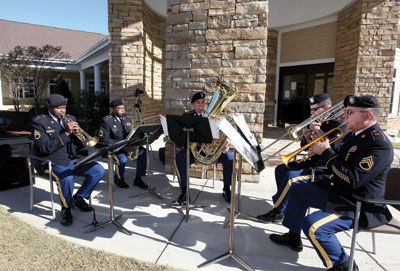 Shirley McConico echoed the sentiment, noting that the proximity of Vincent to Pell City will make her travel for visits easier.
Shirley McConico echoed the sentiment, noting that the proximity of Vincent to Pell City will make her travel for visits easier. Williams Blackstock was the architectural firm for the project, and Marsh noted that its design says style “from beam to beam and stern to stern.” He also thanked Doster Construction for delivering “a magnificent building. They stepped up to meet each challenge” for the state’s largest veterans home.
Williams Blackstock was the architectural firm for the project, and Marsh noted that its design says style “from beam to beam and stern to stern.” He also thanked Doster Construction for delivering “a magnificent building. They stepped up to meet each challenge” for the state’s largest veterans home.













